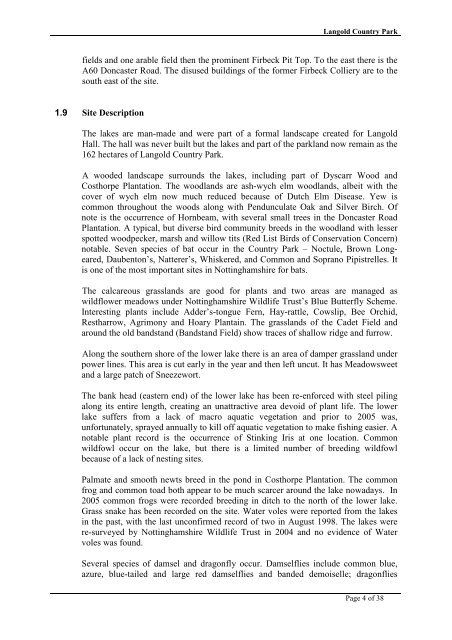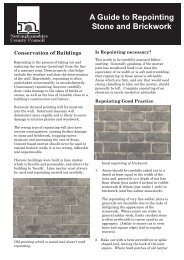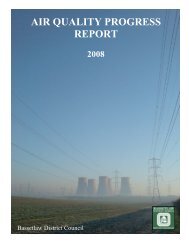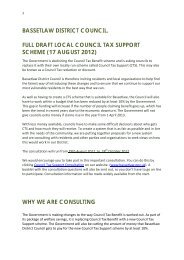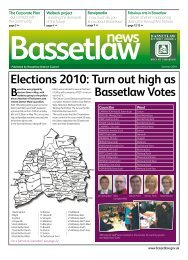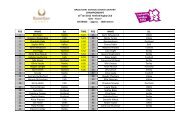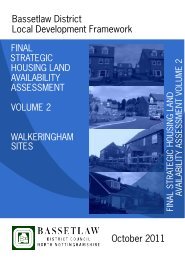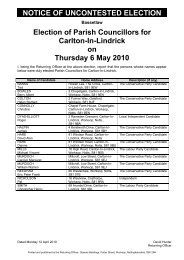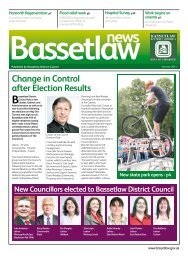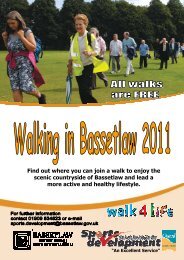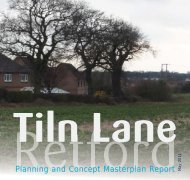Langold Lake Management Plan - Bassetlaw District Council
Langold Lake Management Plan - Bassetlaw District Council
Langold Lake Management Plan - Bassetlaw District Council
You also want an ePaper? Increase the reach of your titles
YUMPU automatically turns print PDFs into web optimized ePapers that Google loves.
<strong>Langold</strong> Country Park<br />
fields and one arable field then the prominent Firbeck Pit Top. To the east there is the<br />
A60 Doncaster Road. The disused buildings of the former Firbeck Colliery are to the<br />
south east of the site.<br />
1.9 Site Description<br />
The lakes are man-made and were part of a formal landscape created for <strong>Langold</strong><br />
Hall. The hall was never built but the lakes and part of the parkland now remain as the<br />
162 hectares of <strong>Langold</strong> Country Park.<br />
A wooded landscape surrounds the lakes, including part of Dyscarr Wood and<br />
Costhorpe <strong>Plan</strong>tation. The woodlands are ash-wych elm woodlands, albeit with the<br />
cover of wych elm now much reduced because of Dutch Elm Disease. Yew is<br />
common throughout the woods along with Pendunculate Oak and Silver Birch. Of<br />
note is the occurrence of Hornbeam, with several small trees in the Doncaster Road<br />
<strong>Plan</strong>tation. A typical, but diverse bird community breeds in the woodland with lesser<br />
spotted woodpecker, marsh and willow tits (Red List Birds of Conservation Concern)<br />
notable. Seven species of bat occur in the Country Park – Noctule, Brown Longeared,<br />
Daubenton’s, Natterer’s, Whiskered, and Common and Soprano Pipistrelles. It<br />
is one of the most important sites in Nottinghamshire for bats.<br />
The calcareous grasslands are good for plants and two areas are managed as<br />
wildflower meadows under Nottinghamshire Wildlife Trust’s Blue Butterfly Scheme.<br />
Interesting plants include Adder’s-tongue Fern, Hay-rattle, Cowslip, Bee Orchid,<br />
Restharrow, Agrimony and Hoary <strong>Plan</strong>tain. The grasslands of the Cadet Field and<br />
around the old bandstand (Bandstand Field) show traces of shallow ridge and furrow.<br />
Along the southern shore of the lower lake there is an area of damper grassland under<br />
power lines. This area is cut early in the year and then left uncut. It has Meadowsweet<br />
and a large patch of Sneezewort.<br />
The bank head (eastern end) of the lower lake has been re-enforced with steel piling<br />
along its entire length, creating an unattractive area devoid of plant life. The lower<br />
lake suffers from a lack of macro aquatic vegetation and prior to 2005 was,<br />
unfortunately, sprayed annually to kill off aquatic vegetation to make fishing easier. A<br />
notable plant record is the occurrence of Stinking Iris at one location. Common<br />
wildfowl occur on the lake, but there is a limited number of breeding wildfowl<br />
because of a lack of nesting sites.<br />
Palmate and smooth newts breed in the pond in Costhorpe <strong>Plan</strong>tation. The common<br />
frog and common toad both appear to be much scarcer around the lake nowadays. In<br />
2005 common frogs were recorded breeding in ditch to the north of the lower lake.<br />
Grass snake has been recorded on the site. Water voles were reported from the lakes<br />
in the past, with the last unconfirmed record of two in August 1998. The lakes were<br />
re-surveyed by Nottinghamshire Wildlife Trust in 2004 and no evidence of Water<br />
voles was found.<br />
Several species of damsel and dragonfly occur. Damselflies include common blue,<br />
azure, blue-tailed and large red damselflies and banded demoiselle; dragonflies<br />
Page 4 of 38


